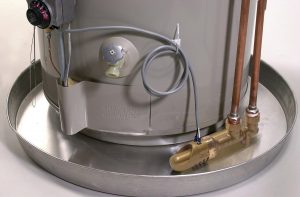
 When it comes to the selection and sizing of your boiler many people get a little confused as to what all the different ratings mean and which rating you should use. Take a look at a manufacturers’ specification sheet and you will see ratings for input, output, net output, efficiencies, and so on.
When it comes to the selection and sizing of your boiler many people get a little confused as to what all the different ratings mean and which rating you should use. Take a look at a manufacturers’ specification sheet and you will see ratings for input, output, net output, efficiencies, and so on.
The first rating to discuss and the easiest is the INPUT rating. This is the measurement of the amount of fuel the boiler will burn and is stated in either Btu/hr (100,000) or Mbh (100) (or in case of oil in Gph, 1 gallon per hour of No2 fuel oil is equal to 140,000 Btu/hr). The input is the rating you should use to size your gas piping system and your venting, although with today’s ModCon boilers the venting is sized by the manufacturer and based on length of the vent. The input is also used to determine the efficiency of the boiler for example; a boiler with an input of 150,000 Btu/hr and a gross output of 135,000 would have an estimated combustion efficiency of 135,000÷150,000= .90×100=90% eff.
Next we have the boiler output, which can be listed in several ways. Which one to use is really dependant on the actual installation of not only the boiler but the distribution piping as well. First let’s take a look at the different rating for output, where they come from and then how to use them.
1) IBR Gross Output: This is the amount of heat energy actually transferred to the water during steady state operation. The assumption of this particular rating is that any heat lost through the boiler jacket is wasted and does not contribute to the building heating load. This rating assumes the boiler is in an unheated space.
2) Net IBR Output: This is a further arbitrary deduction of 15 per cent from the IBR Gross Output that takes into account the losses from the distribution piping and the necessary Btus it takes to bring the system up to operating temperature, or in other words pick up allowances. This again assumes these losses do not contribute to the building heat load and the boiler and the distribution piping is installed outside of the heated space. A note about the 15 per cent deduction, this percentage has not changes in 50 years, even before my time in the business, before that the deduction was 33 per cent. With today’s boilers and the use of outdoor reset and the use of smaller pipes, how many houses are installed with 2 in. steel pipe these days, I think this could be looked at again and lowered to lets pick a number say 10 per cent.
3) Heating Capacity: A further rating we have is the heating capacity either shown as DOE or CSA Heating Capacity also called Gross Output. This rating like the IBR Gross Output rating is stated as the amount of heat energy transferred to the system water. However the heat lost from the boiler jacket, piping losses and pick-up allowances are assumed to contribute to the building’s heating load. This assumption means the boiler and piping is thought to be located in the heated space. The Heating Capacity rating will always be higher than the IBR Gross output rating because of this factor.
Now that we see what the ratings are and where they come from, let’s look at how to best use them for a particular application.
First and the highest rating is the Heating Capacity or Gross Output. Since this rating allows for the jacket losses of the boiler and distribution piping to be used in the supply of the build heating load, this output should only be used if 1) The boiler is within the heated space, and 2) all or most of the distribution piping is also within the heated space. This loss would otherwise not contribute to the heat load of the building and the selected boiler size could be inadequate.
Next we have the IBR Gross Output, which is calculated excluding the boiler jacket losses, but not the piping and pick-up losses. Therefore we would use this output rating when the boiler is located in an unheated space, such as the garage or unheated crawlspace, and the piping or most of it is located within the heated space. The difference between the CSA/DOE Heating Capacity and the IBR Gross output is fairly insignificant and either one would be acceptable in this case.
The final output is the IBR Net Output. This output should be used for systems where neither the boiler nor the distribution piping is in the heated space, such as a garage, crawlspace or unheated basement. Keep in mind that the deduction of 15 per cent from the IBR Gross Output is used for normal piping systems. Such systems as older cast iron radiator or those with large piping runs may require more than the 15 per cent allocated to these losses. If in doubt you can always calculate the losses from the actual piping system if necessary. Also, if the boiler manufacturer does not provide this rating just reduce the CSA heating capacity by 15 per cent.
Also many of today’s high efficiency boilers have very little jacket losses or even standby losses as was a concern with older atmospheric draft boilers.
Other ratings you will find in manufacturers literature will be efficiency ratings such as combustion efficiency, steady state efficiency and AFUE (Annual Fuel Utilization Efficiency).
First let’s look at Combustion Efficiency; it is a measure of the boilers efficiency at steady state operation. This is done by measuring the temperature of the exhaust gases, which are very low in today’s ModCon boilers, and the measure of the CO2 content of the exhaust gases when the boiler is firing at steady state conditions. The lower the exhaust gas temperature and the higher the CO2 content the more efficient the appliance is operating.
Next up will be the Steady State Efficiency. This is estimated by dividing the Heating Capacity by the Fuel Input Rating (Btu/h). For example, if we have a natural gas boiler with an input rating of 100,000 Btu/h and a heating capacity of 85,000, we would have a steady state efficiency of 85 per cent. This steady state can only be measured when the boiler is at full load and all the conditions, such as return water temperature, air temperature, air/fuel ration, and so on remain constant. This of course rarely happens in the field and may only be achieved in the laboratory under ideal conditions.
Annual Fuel Efficiency Utilization Efficiency or AFUE ratings, is the most important rating when comparing one appliance to another or trying to estimate the seasonal operating costs of the appliance. This rating is only applied to boilers with an input rating of 300Mbh or less. This rating is achieved by taking into account all aspects of operation, on-cycle and off-cycle performance and partial load performance, etc. The standard for AFUE values are based on the assumption that the boiler are installed in a heated space of the home eliminating jacket losses, also the boiler capacity is considerably larger (50 to 70 per cent) than the actual heating load of the building. So two things that can change the actual AFUE rating is first When the boiler is installed in an unheated space where jacket losses are waste heat, and second the closer the boiler is sized to the actual heating load of the building the seasonal efficiencies may be higher than stated. This is one of the reasons why it is important to do an accurate room by room heat loss estimate and use the proper boiler output rating for a particular type of installation.
Something else that is not taken into consideration when choosing the correct boiler size is zoning. When zoning a home we reduce the required load on the boiler, for example if we have a home with four zones fairly even in size and the total load is 100 Mbh what are the chances that all four zones call at once. It is very reasonable to assume some diversity in the operation of this home and I would be very comfortable eliminating the smallest zone from the total building heat load and use the output rating that suits the type of installation for my boiler selection where the boiler is in the heated space. There are controls system on the market today that will monitor and control the zone diversity to make sure adequate heat is provided to all zones.
Leo Vaillancourt is a well-known hydronic advocate and trainer. He was most recently with Navien as its trainer for Western Canada.





